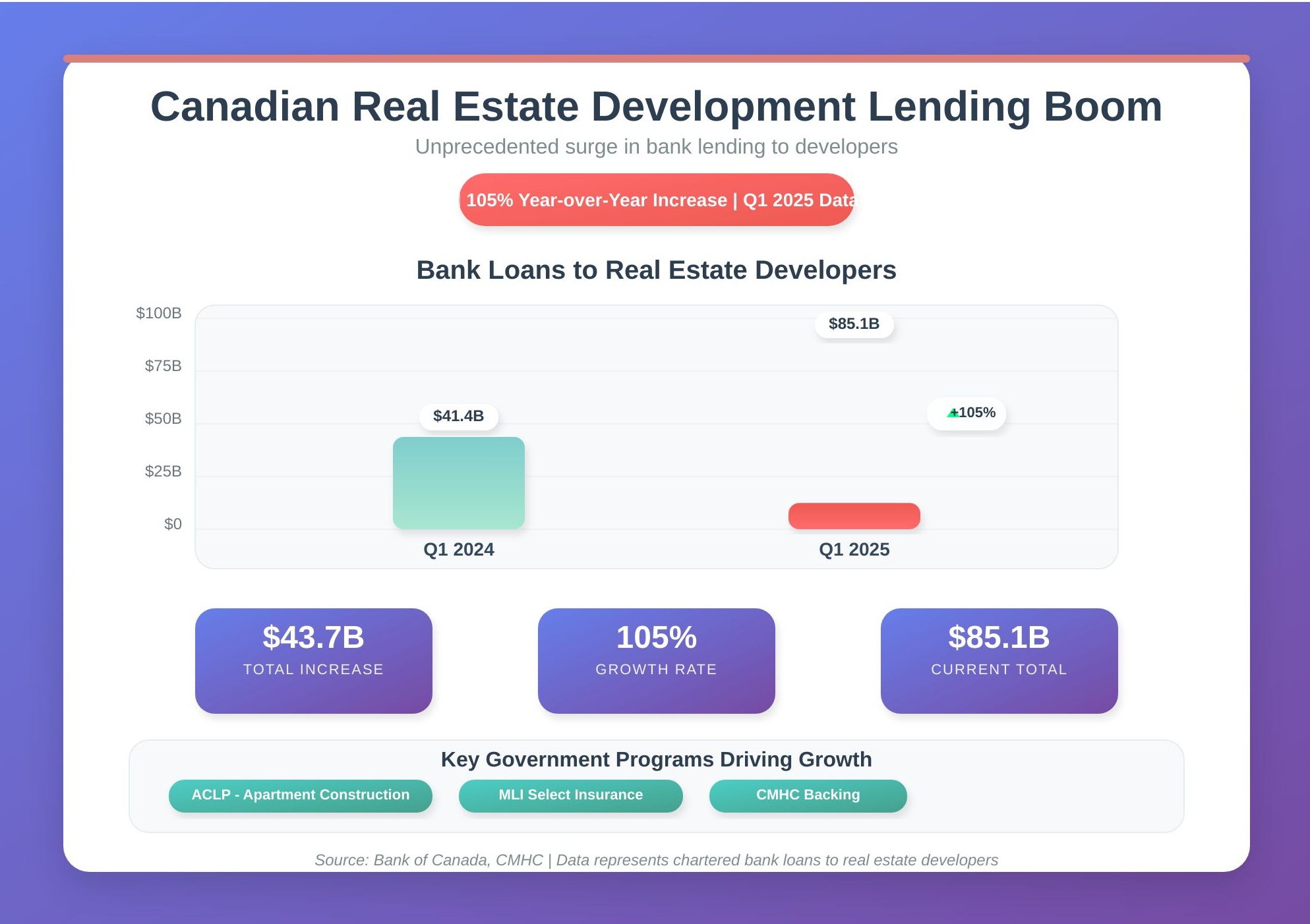Canada’s Real Estate Development Lending Boom: $85.1 Billion Surge Raises Housing Affordability Questions
Last Updated: June 15, 2025 | 8 min read
Canada’s real estate development sector is witnessing an unprecedented financial transformation that’s reshaping the entire housing landscape. With bank lending to developers surging by an extraordinary 105% in just one year, reaching $85.1 billion in Q1 2025, questions are mounting about who’s really benefiting from this boom—and who’s paying the price.
The Numbers Behind Canada’s Real Estate Lending Explosion
The statistics tell a remarkable story of rapid change in Canadian real estate finance. Chartered bank loans to real estate developers have experienced their most dramatic increase in decades, jumping by $43.7 billion year-over-year. This surge represents a fundamental shift from the traditionally cautious approach Canadian banks have taken toward development lending.
To understand the magnitude of this change, consider that this single-year increase exceeds the total lending growth seen across entire decades of previous real estate cycles. The peak of this growth began in late 2024, creating a lending environment unlike anything Canada has experienced in modern real estate history.
Why Canadian Banks Suddenly Embraced Real Estate Development Lending
For decades, Canadian financial institutions maintained a conservative stance on real estate development loans. The inherent risks associated with construction projects—including cost overruns, market volatility, and completion delays—made traditional lenders exceptionally cautious about this sector.
This caution forced many Canadian developers to seek expensive private financing options, often at rates 200-300% higher than conventional bank lending. The high cost of capital created significant barriers to development, particularly for smaller builders and innovative housing projects.
The recent transformation didn’t happen in isolation. The surge in bank lending aligns directly with expanded government intervention in the housing market, particularly through enhanced programs from the Canada Mortgage and Housing Corporation (CMHC).
Government Programs Transforming Canadian Real Estate Finance
Apartment Construction Loan Program (ACLP): The Catalyst for Change
The ACLP’s 2023 expansion has become the cornerstone of Canada’s new approach to development financing. By providing government guarantees for later-phase financing, this program fundamentally altered the risk calculation for Canadian banks. To learn more about the ACLP Program, please click here
When lenders know the government will backstop the most critical phases of development—typically when projects are most vulnerable to market changes—their willingness to provide initial construction capital increases dramatically. This government backing has effectively removed the primary barrier that prevented banks from entering the development lending market more aggressively.
Mortgage Loan Insurance (MLI) Select: Supercharging Development Capital
The 2022-2023 enhancements to MLI Select have proven equally transformative for Canadian real estate development. With leverage limits increased and project caps raised to an unprecedented $1.5 billion, developers can now access levels of financing that were previously impossible through traditional channels. To learn more about the CHMC & the MLI Select Program, please click here
This program expansion has particular significance for large-scale developments and institutional real estate projects. The increased project caps enable development of major residential complexes, mixed-use developments, and large rental housing projects that can significantly impact local housing supply.
The Hidden Cost: How Taxpayers Are De-Risking Canada’s Real Estate Market
While these government programs have successfully unlocked billions in private lending, they’ve also created a fundamental shift in risk allocation. The financial risk that was once borne by banks and developers has been transferred to Canadian taxpayers through government guarantees and backing.
This risk transfer extends beyond direct program costs. When the government increases borrowing to support these loan guarantee programs, it drives up the overall cost of credit throughout the Canadian economy. The result is higher borrowing costs for Canadian families seeking mortgages, businesses requiring capital, and consumers using credit facilities.
The indirect cost to households is substantial and often overlooked in policy discussions. Every Canadian with a mortgage, business loan, or credit facility effectively subsidizes real estate development through elevated interest rates caused by increased government borrowing.
The Affordability Paradox in Canadian Housing Policy
Despite positioning these lending programs as solutions to Canada’s housing affordability crisis, the actual outcomes present a more complex picture. Analysis of projects receiving government-backed financing reveals that many require only 20-30% of units to be priced below market rates.
This means the majority of housing units in these developments sell or rent at market prices or above, raising questions about whether public resources are effectively addressing affordability challenges or primarily benefiting developers and institutional investors.
The concentration of government-backed lending among large institutional landlords has created additional concerns. Critics argue that when major real estate investment trusts and institutional operators dominate government-supported projects, it may actually accelerate rent increases compared to markets dominated by smaller, local operators.
Long-Term Implications: The 55-Year Mortgage Question
Recent policy changes have introduced even more aggressive financing terms, with developers now able to extend loan repayment periods up to 55 years. This ultra-long-term financing approach creates several concerning dynamics in the Canadian real estate market.
Extended repayment terms artificially inflate asset values by reducing the apparent cost of borrowing. When developers can spread loan payments across five decades, it enables higher purchase prices for development sites and increased project costs—expenses that ultimately flow through to housing prices and rents.
Perhaps more significantly, these 55-year terms extend taxpayer exposure across generations. Current housing policies may create financial obligations that Canadian taxpayers will be servicing well into the 2080s, raising fundamental questions about intergenerational equity and fiscal responsibility.
Market Dynamics: Winners and Losers in Canada’s Lending Boom
The surge in government-backed development lending has created distinct winners and losers in the Canadian housing ecosystem:
Clear Winners: Large institutional developers with sophisticated financing capabilities have gained significant advantages. These organizations can navigate complex government programs and leverage multiple funding sources to secure prime development opportunities.
Canadian banks are enjoying government-guaranteed returns on development loans, combining the profit potential of real estate lending with significantly reduced risk exposure.
Established real estate investment trusts (REITs) and institutional landlords can expand their portfolios using preferential government-backed financing terms, consolidating market share in rental housing.
Potential Losers: Smaller developers face increased competition for projects while lacking access to the same government-backed financing advantages enjoyed by larger competitors.
Canadian taxpayers bear growing financial risk through loan guarantees while potentially facing higher borrowing costs across all forms of credit.
Housing seekers may encounter higher rents in institutionally-owned buildings, as large operators optimize returns on government-supported investments.
Economic Impact Beyond Housing: Canada’s $43.7 Billion Stimulus
The massive increase in development lending represents more than housing policy—it’s effectively a $43.7 billion economic stimulus with far-reaching implications across multiple sectors.
This capital injection is driving significant economic activity, creating construction jobs, increasing demand for building materials, and generating business for professional services firms. The multiplier effect of construction spending typically generates additional economic activity worth 1.5-2 times the initial investment.
However, economists caution that artificially stimulated lending markets can create resource allocation distortions. When government guarantees make development lending “too easy,” markets may direct capital toward projects that wouldn’t be viable under normal risk assessment, potentially leading to overbuilding in some segments while underserving others.
International Context: How Canada Compares Globally
Canada’s approach to government-backed development lending is notably more aggressive than most comparable developed nations. While countries like Australia, the United Kingdom, and Germany operate similar programs, the scale and scope of Canadian intervention is unprecedented among major economies.
This positions Canada as a real-world laboratory for large-scale government intervention in housing markets. The results of this experiment will likely influence housing policy discussions worldwide, making Canada’s experience particularly significant for international observers.
Implications for Canadian Homebuyers and Renters
For prospective homebuyers, the lending surge presents both opportunities and challenges. Increased development activity should theoretically improve housing supply, potentially moderating price growth in tight markets.
However, government-backed projects often target higher-end market segments, doing little to improve affordability for first-time buyers or families with moderate incomes. The focus on large-scale, institutionally-developed projects may actually reduce the diversity of housing options available to different income levels.
Renters face particularly complex implications. While new rental construction is accelerating thanks to government-backed financing, much of this new supply is controlled by large institutional landlords who prioritize investment returns.
The concentration of rental housing ownership in fewer hands could reduce competitive pressure on rents, particularly as these institutions seek to optimize returns on government-supported investments.
Critical Policy Questions for Canada’s Housing Future
As this lending boom continues to reshape Canadian real estate markets, several fundamental questions demand urgent attention from policymakers:
Effectiveness Assessment: Are these programs delivering genuinely affordable housing for Canadian families, or are they primarily benefiting developers, banks, and institutional investors at taxpayer expense?
Fiscal Sustainability: Can Canadian taxpayers continue to absorb the growing financial risks associated with backstopping private real estate development, particularly as loan terms extend to 55 years?
Equity and Access: Do these policies help Canada’s most vulnerable housing seekers, or do they primarily benefit those who already have access to housing and investment capital?
Market Distortion Risks: What happens to Canadian housing markets when government support eventually winds down, and are current policies creating unsustainable market conditions?
Long-term Accountability: How will policymakers ensure these programs serve public rather than private interests over the multi-decade terms now being offered?
Monitoring Canada’s Housing Policy Experiment
The 105% surge in development lending represents just the beginning of what may prove to be Canada’s most significant housing policy experiment in generations. As projects financed through this lending boom come to market over the next 2-3 years, their impact on housing supply, affordability, and market dynamics will become increasingly clear.
The success or failure of this approach will likely influence housing policy across the developed world, making Canada’s experience a critical case study for governments grappling with housing affordability challenges.
Canadian policymakers face the ongoing challenge of balancing short-term housing supply goals with long-term fiscal responsibility and market stability. The decisions made in the coming years will shape Canadian housing markets for decades to come.
The Road Ahead: Balancing Growth and Responsibility
Canada’s decision to use taxpayer resources to de-risk private real estate development represents a clear departure from market-based approaches to housing policy. By choosing intervention over market mechanisms, Canadian governments have prioritized rapid supply creation over traditional concerns about fiscal responsibility and market efficiency.
Whether this strategy ultimately improves housing affordability for ordinary Canadians—or simply redistributes wealth from taxpayers to developers and institutional investors—will be determined by the projects and market outcomes emerging from this lending boom.
What’s certain is that the stakes have never been higher for Canadian housing policy. The financial risks have never been more widely distributed, and the potential consequences—both positive and negative—have never been more significant for Canadian families and communities.
Conclusion: A Defining Moment for Canadian Housing
The doubling of bank loans to real estate developers in a single year marks more than a statistical milestone—it represents a fundamental transformation in how Canada approaches housing development and market intervention.
As this bold experiment in government-backed development lending continues to unfold, its results will not only determine the future accessibility and affordability of Canadian housing but may also reshape how governments worldwide think about their role in housing markets.
The ultimate test of this policy approach will be whether it delivers on its promise of improved housing affordability for Canadian families, or whether it primarily benefits the financial and real estate industries at taxpayer expense. That answer will define Canadian housing policy for a generation.
Stay informed about Canadian real estate development trends and housing policy analysis by subscribing to our newsletter. Get the latest insights on market developments, policy changes, and their implications for Canadian families and investors.
Related Topics: Canadian Housing Policy | Real Estate Development Financing | CMHC Programs | Government-Backed Lending | Housing Affordability Crisis

 Facebook
Facebook
 X
X
 Pinterest
Pinterest
 Copy Link
Copy Link

